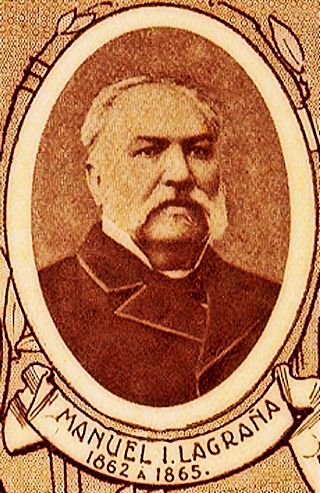
San Juan Capistrano is a city in southern Orange County, California, United States. The population was 35,253 at the 2020 Census.

Misiones is one of the 23 provinces of Argentina, located in the northeastern corner of the country in the Mesopotamia region. It is surrounded by Paraguay to the northwest, Brazil to the north, east and south, and Corrientes Province of Argentina to the southwest.

Corrientes, officially the Province of Corrientes is a province in northeast Argentina, in the Mesopotamia region. It is surrounded by : Paraguay, the province of Misiones, Brazil, Uruguay, and the provinces of Entre Rios, Santa Fe and Chaco.

Resistencia is the capital and largest city of the province of Chaco in north-eastern Argentina. According to the 2010 census, the population of the city proper was 291,720 inhabitants. It is the anchor of a larger metropolitan area, Greater Resistencia, which comprises at least three more municipalities for a total population of 387,340 as of 2010. This conurbation is the largest in the province, and the eleventh most populous in the country. It is located along the Negro River, a tributary of the much larger Paraná River, opposite the city of Corrientes, Corrientes Province.

Corrientes is the capital city of the province of Corrientes, Argentina, located on the eastern shore of the Paraná River, about 1,000 km (621 mi) from Buenos Aires and 300 km (186 mi) from Posadas, on National Route 12. It has a population of 346,334 according to the 2010 Census. It lies opposite its twin city, Resistencia, Chaco.

The Paraná River is a river in south-central South America, running through Brazil, Paraguay, and Argentina for some 4,880 kilometres (3,030 mi). Among South American rivers, it is second in length only to the Amazon River. It merges with the Paraguay River and then farther downstream with the Uruguay River to form the Río de la Plata and empties into the Atlantic Ocean.

Reconquista is a city in the north of the province of Santa Fe, Argentina, 327 km (203 mi) from the provincial capital. It is the head town of the General Obligado Department, and it has 99,288 inhabitants according to the 2010 census [INDEC].

Curuzú Cuatiá is a city in the south of the province of Corrientes in the Argentine Mesopotamia. It had about 34,000 inhabitants at the 2010 census [INDEC], and is the head town of the Curuzú Cuatiá Department.

Lavalle is a town in Corrientes Province, Argentina. It is the capital of Lavalle Department. It is located on the banks of the Paraná River, between the cities of Goya and Santa Lucía. It is located 207 kilometers from the provincial capital.
Santa Lucía is a city in the province of Corrientes, Argentina. It has 11,589 inhabitants as per the 2010 census [INDEC]. It lies on the western shore of the Santa Lucía River, between this river and the nearby Paraná, about 20 km northeast from the city of Goya and 170 km south from the provincial capital Corrientes.

Song of the Swallows is a children's book written and illustrated by Leo Politi. Published by Scribner, it was the recipient of the Caldecott Medal for illustration in 1950.
La Hora de María y el pájaro de oro is a 1975 Argentine film.

National Route 12 (RN12) is a road in Argentina, connecting the northeast section to the rest of the country. It runs through the provinces of Misiones, Corrientes, Entre Ríos and Buenos Aires.

The Argentine North Eastern Railway (ANER) was a British-owned railway company, founded in 1887, that operated a 1,435 mmstandard gauge railway network in the provinces of Entre Ríos, Corrientes and Misiones in Argentina. When the company was nationalised in 1948 it became part of the state-owned General Urquiza Railway.

Ricardo Ramón López Jordán (1822–1889) was an Argentine soldier and politician, one of the last influential "caudillos" in the history of Argentina. He thrice rebelled against the government of Buenos Aires and was defeated in each attempt.

The Battle of Corrientes occurred at the beginning of the Paraguayan War during the second stage of the Paraguayan offensive, after the invasion of Mato Grosso at the beginning of 1865.

Argentine cheese is by far the most produced dairy product in the country, making Argentina the second largest cheese producer in Latin America and among the top 10 cheese-producing countries in the world. In addition, Argentina is the Latin American country that consumes the most cheese, with 12 kilos per capita per year. Production is mainly centered in the provinces of Córdoba, Santa Fe and Buenos Aires, in the Pampas region of the central and east-central parts of the country.

The Corrientes campaign or the Paraguayan invasion of Corrientes was the second campaign of the Paraguayan War. Paraguayan forces occupied the Argentinian city of Corrientes and other towns in Corrientes Province. The campaign occurred at the same time as the Siege of Uruguaiana.

Manuel Ignacio Lagraña was an Argentine politician and military figure. He was the 21st and 23rd Governor of Corrientes Province and the governor of the province when the Paraguayans invaded the province during the Corrientes campaign of the Paraguayan War.

Ramón Antonio Mora y Araujo was an Argentine politician and diplomat, who served as his country's ambassador to Brazil (1922–1933) and Peru (1933–1936).




















